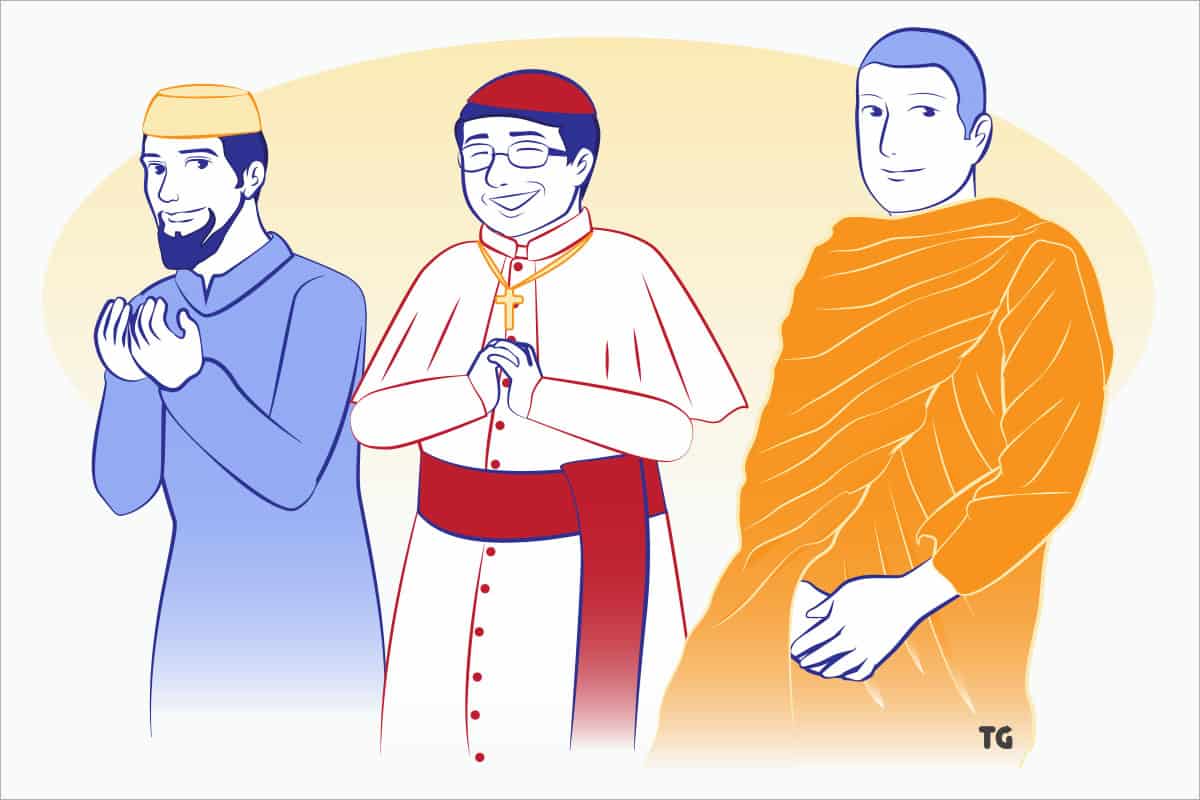Like everything else in the country, Thai people are open-minded towards religions. Many major religions of the world manage to find a space in this multicultural country. However, you might want to know which religion or belief impacts Thailand the most. So, what is the main Thailand religion?
Buddhism is the main religion of Thailand. With more than 93% of the population as Buddhists, Thailand is one of the few Buddhist countries on the planet. The second most influential religion in Thailand is Islam, followed by Christianity. Hinduism and Sikhism are also noticeable in the country.
With that said, you might be curious about the relationship between Thailand and all religions. Read on and find out more about the religious aspect of Thailand.
What is Thailand’s national religion?
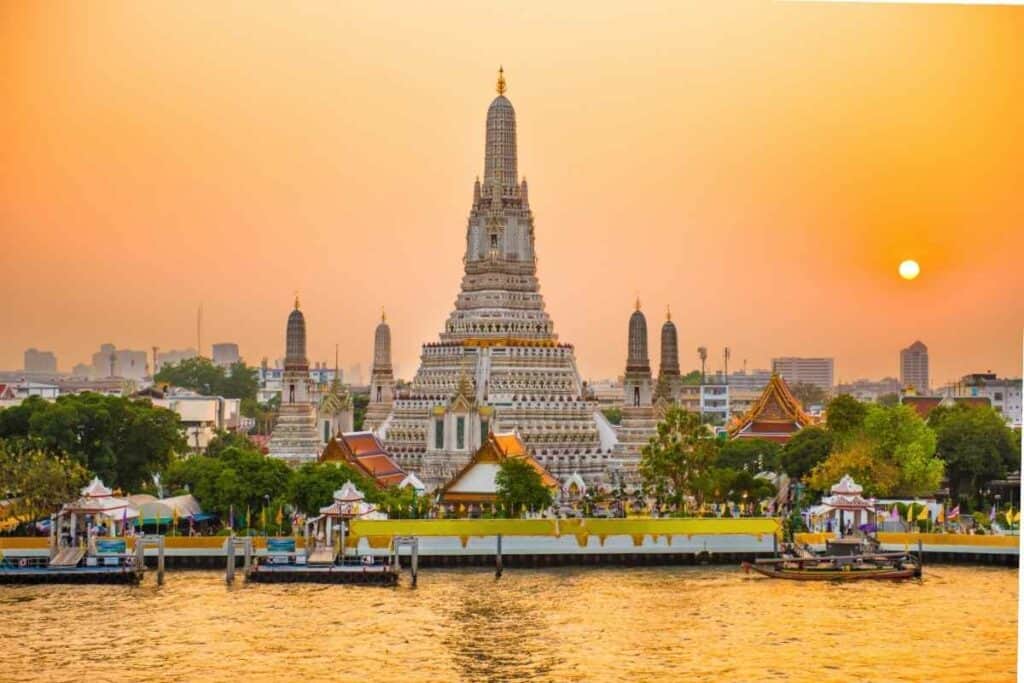
Thailand has Buddhism as its national religion — and that is self-evident.
As of 2018, more than 93% of the Thai population (around 63.3 million people) are Buddhists. (Source)
According to the National Office of Buddhism, there are more than 42,000 Buddhist temples in Thailand. And in 2020, there were more than 200,000 Buddhist monks. (Source)
And if the statistics still haven’t convinced you that Thailand is a Buddhist country, you need to look at its national flag.
The locals call their national flag the “Tri-color” flag. There are 3 colors in there: red, white, and blue. The white represents the pureness of Buddhism, while red and blue symbolize the nation and monarchy.
And what does that mean? It means that Buddhism has a massive impact that the locals have to put on their national flag together with the monarchy and the nation itself.
And that might come as no surprise to you. After all, Thailand and Buddhism have been holding hands for a long time. They have seen many ups and downs together. And this relationship seems to be continuing for as long as you can imagine.
How did Buddhism enter Thailand?
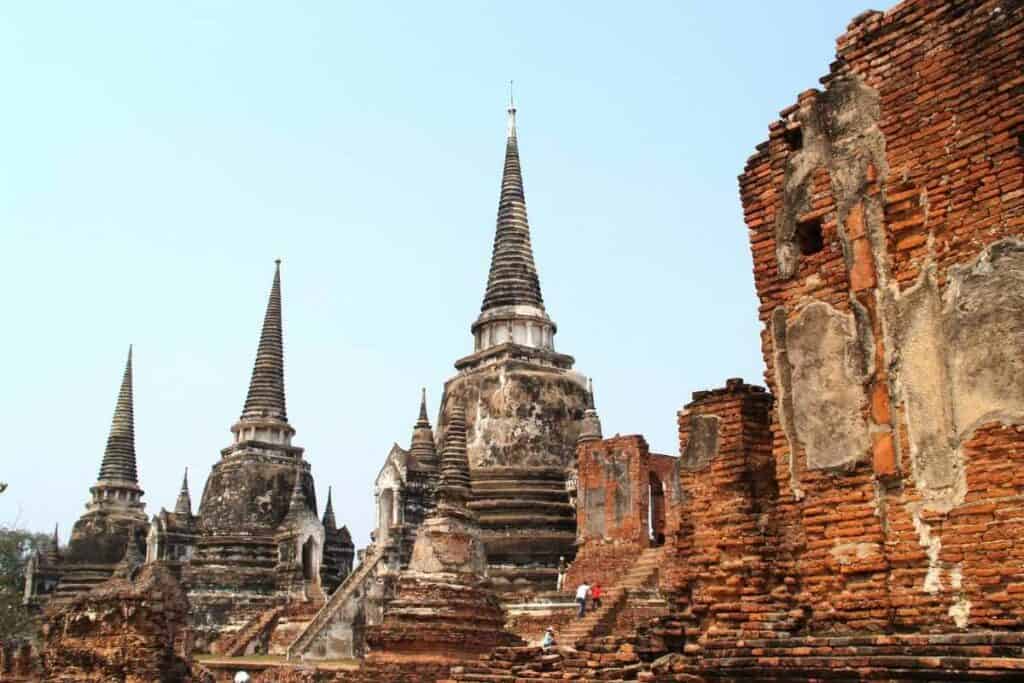
Indian history fans would probably know the answer already. But if you’re not one, here’s a quick recap.
Around 307 B.C, King Ashoka the Great of India (325 B.C. – 283 B.C.) decided to expand the influence of Buddhism to the rest of the world. He sent many “missionary” monks to various areas of Asia. And among those areas was the land of Suvarnabhumi.
If Suvarnabhumi sounds familiar to you, that’s because it’s the name of Thailand’s largest international airport. However, this name means something different in the ancient days. It was the name referring to a region consisting of what became Thailand, Myanmar, Sri Lanka, Vietnam, Cambodia, Laos, and Malaysia.
King Ashoka the Great assigned 2 “missionary” monks to Suvarnabhumi: Sona Thera and Uttara Thera. Thanks to their effort, Buddhism finally took root in the area.
Many historians believe that Buddhism first saw its boom in Thailand during the ancient Thawarawadee kingdom (now Nakhon Pathom). Much evidence in Thawarawadee pointed at the flourishing of Buddhism, including the massive Phra Pathom Chedi and the many sculptures of Dharmachakra with crouch deers. (Source)
After that, Buddhism continued its influence over the area. It found its way to the Sukhothai and Ayutthaya kingdom and stuck with the Thai people throughout history.
There was never a monarch in Thai history who wasn’t a Buddhist. The Thai royal family has been an essential advocate of this religion since ancient times. But that didn’t mean they banned other religions. Thai people are free to choose their faith and belief as long as they don’t harm others.
Which sect of Buddhism do Thai people practice?
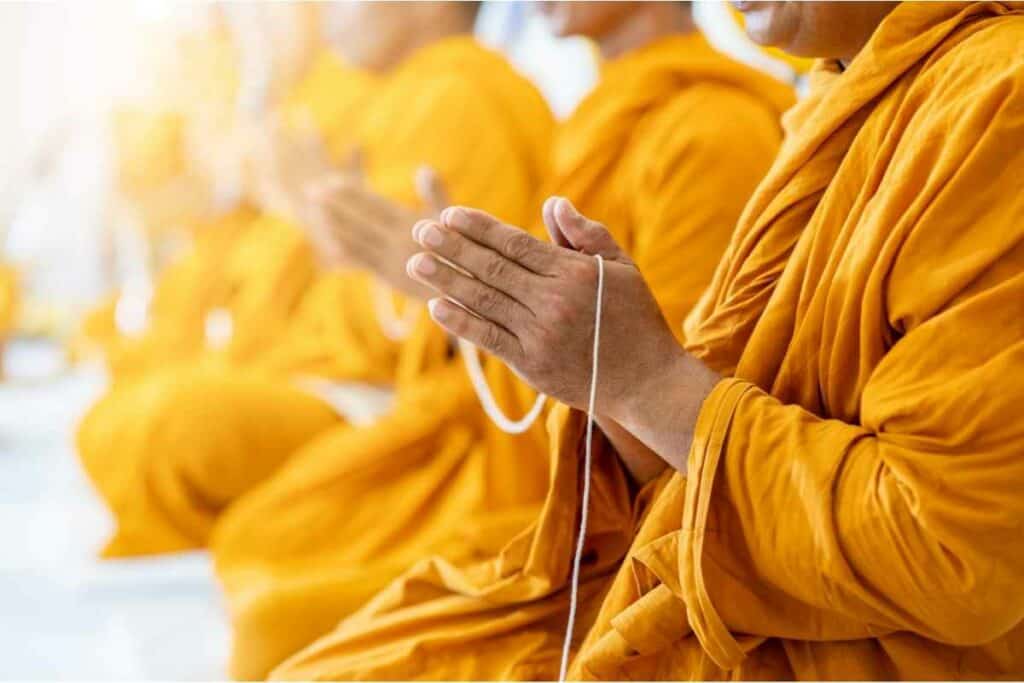
Like other major world religions, Buddhism is separated into many sects. The two major ones are Theravada and Mahayana. And the one that has more members in Thailand is Theravada.
There are many differences between Theravada and Mahayana. However, the main difference is that the former focus on individual success in reaching Nirvana while the latter focus on collective success.
This means Theravada Buddhists will throw their effort into enhancing their personal spirit and reach Nirvana as soon as possible. Mahayana Buddhists, however, will focus on helping as many people reach Nirvana first and self-achievement later.
As a result, Theravada’s teaching is relatively closer to the original. Mahayana’s doctrine is altered to make Buddhism appear more accessible and appealing to the mass.
But despite their differences, both sects still aim for their followers to reach the ultimate goal of Nirvana.
However, the interpretation of one religion could vary in many countries — like how Catholicism in England might differ from Catholicism in The United States. And this rule applies to Thailand too.
Thai Theravada might be completely different from what you have heard of. Why? Because the locals have mixed the “Thainess” into the religion — altering parts of the teaching to fit the existing culture.
Many Thai Buddhists also believe in Hinduism gods. Thai people are well-versed in Hindu Mythology and folklore. And with that knowledge, they blend Hindu elements into Buddhism too.
One of the prominent examples is Chaiwatthanaram Temple. This ancient temple was built to have the same diagram as the Universe of Hinduism. Other examples can be seen in many Hindu shrines across the country. Each shrine is constructed for different gods, and most gods also have multiple shrines.
So, you can almost say that Thai Theravada Buddhism is quite strange. Why? Because Buddhists usually don’t believe in gods or deities. However, Thai Buddhists also believe in and respect multiple Hindu gods, seeking the blessing they offer.
The main religions in Thailand other than Buddhism
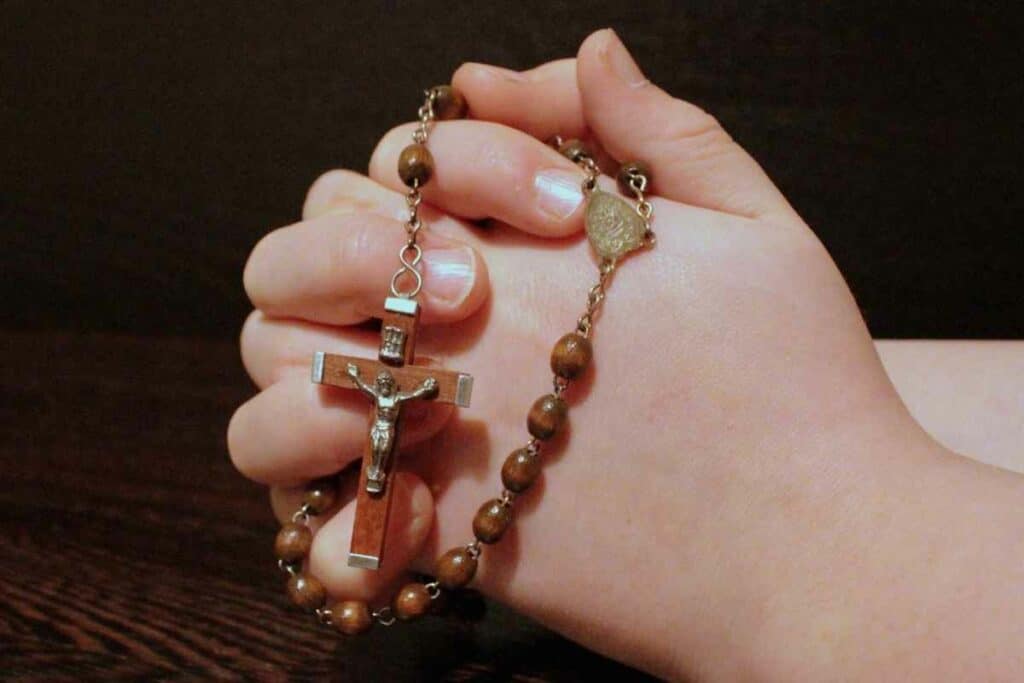
As mentioned, Thailand doesn’t force its people to be Buddhists. You can choose your belief, faith, and religion as you please. As a result, other prominent religions also find their roots in this country.
Islam:
Islam is the 2nd most influential religion in Thailand after Buddhism. You can see Muslims around the local market with other Thais without separation.
In 2018, there were around 3.6 million Muslims in Thailand. That was roughly 5% of the population. (Source)
And most Muslims are a member of the Sunni sect — a major sect of Islam alongside the Shia.
With such a massive member, many Muslims founded their own community in major cities of Thailand. However, the largest Muslim community in the country is undoubtedly in the south.
The further south you go in Thailand, the more Muslims you meet. This is assumable because Malaysia (a country with Islam as the official religion) is adjacent to the southern border of Thailand. So, their culture finds its way in.
In these Muslim communities, you can find mosques and Muslim schools to visit. Most Muslims are strict with their religious part of life — especially compared to their Buddhist counterparts. This might be an effect of how Islam teaching is more involved in their daily life than Buddhism — like how they dress and eat.
Christianity:
Even though Christianity is the biggest religion in the world, only 1% of the Thai population — around 767,000 people — are Christians as of 2018. (Source)
Most Thai Christians are of the Catholicism sect. You can see that famous Christian Churches in Thailand are Catholic. For example, Assumption Cathedral and the Cathedral of Immaculate Conception.
Why Christianity didn’t bloom in Thailand is probably the prejudice of Thai ancestors. They view Christianity as a culture of “Farang” (a term Thai people use to refer to white westerners). The difference in outer appearance might be too uncanny for the ancient Thai people to readily accept everything.
But of course, that didn’t mean Thailand banned Christianity. Christian missionaries were still free to roam around, preach, and build churches and schools. However, the influence of the already existing Buddhism was probably too strong to overcome. So, Christianity has never found its boom in Thai society.
Of course, it would be a lie to say that Christianity has zero impact on Thai lives. For example, Thai people celebrate Christmas together with the International New Year. Even though the joyous-religious atmosphere is lackluster, the festivity vibe is still strong.
Other notable religions in Thailand
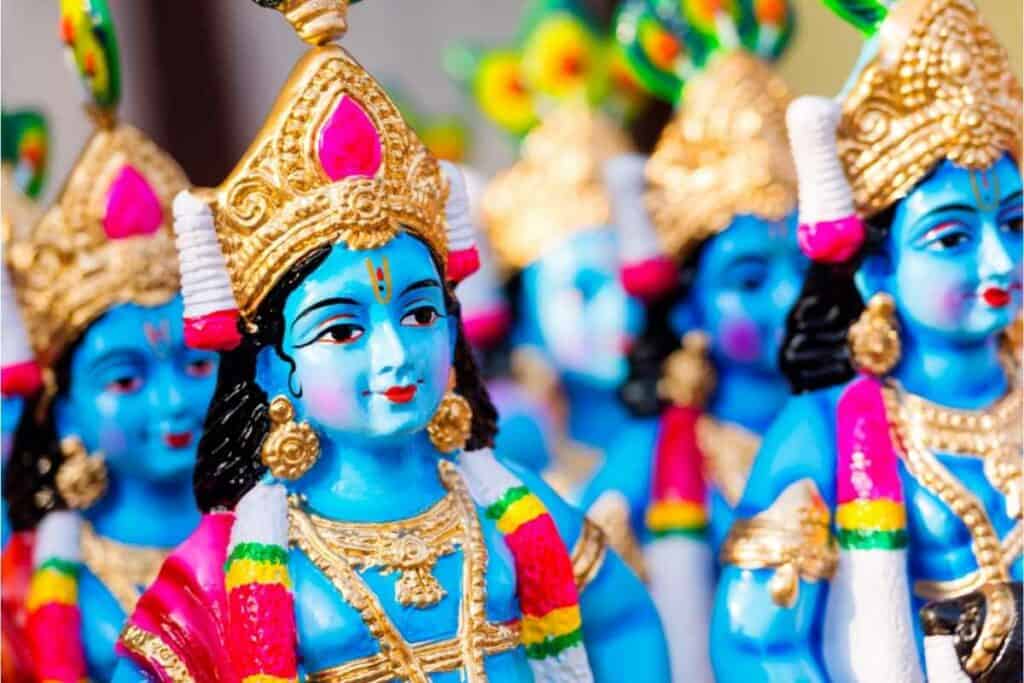
Of course, besides the big three, other religions also have their place in Thailand. And here are 2 notable examples.
Hinduism:
If you love history, you will know that Hinduism is older than Buddhism. So, it’s no surprise that Hinduism had been in Thailand even before the arrival of Buddhist “missionaries” from India.
Consequently, Hinduism has a special place in Thai people’s hearts.
You can see Hinduism in Thailand similarly to the greek-roman Mythology in Europe. Many Thai folktales and fables have the godly characters of Hindu Myth.
And not only that. Many temples and religious sites in Thailand have Hindu motifs in Architecture and interior designs — like the wall and ceiling paintings.
So even though Hinduism only manages to maintain less than 1% of the Thai population as its followers, you can say that it still has massive influence over the country.
Many Thai festivals — especially those related to royalty — still have Hindu rituals performed. These festivals include Coronation Day and Royal Ploughing Ceremony.
Sikhism:
Even though Sikhism has only less than 1% of the Thai population as followers, you can still say that this number is significant.
If you haven’t heard of Sikhism, that is okay. Although it’s one of the 5 largest world religions, not many people discuss its origin and teaching — especially in Thailand. If you asked around, some people in this country wouldn’t know what Sikhism is.
Sikhism has the weakest influence on Thai culture among other religions. You can barely see a glimpse of Sikh culture in the Thai lifestyle. And that is the Sikh communities in the country. There are several Sikh schools in major cities of Thailand, and they are exclusive.
Like Muslims, you can tell if someone is a Sikh by looking at their headwear. Both men and women of Sikhism have to wear a signature headdress that covers most of their hair. However, it still doesn’t stop them from living like other Thai Buddhists, Muslims, or Christians.
Now that you get the overview of Thailand’s religious scene, you might want to look at something less defined but more superstitious.
Thailand and paganism
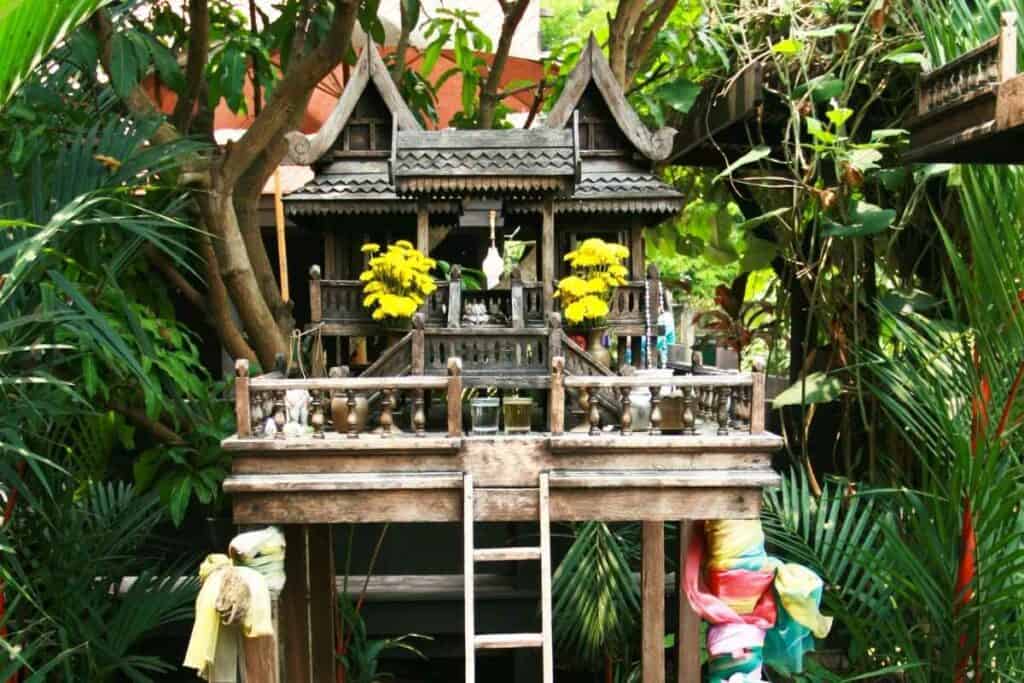
Technically, Paganism is not a religion. However, its influence over Thailand doesn’t differ much from other firmer beliefs.
Nowadays, most Thai people are still superstitious and believe in spirit, magic, and shamanism. And this unique faith is reflected in numerous ways. Here are some notable examples.
- Many Thai families have a small pagan shrine in front of their houses. They believe that the guardian spirit of their household needs a proper living space, so they build a house for these spirits. They also occasionally offer food and drinks to these spirits.
- Many people in Thailand claim to be shamans or mediums and can communicate with the spirit. While the legitimacy of these people is questionable, you can’t deny the positive effect they have on people’s lives. They can give guidance and lead people to a better life path.
Of course, scammers exist among these so-called spiritualists. So if you want to get involved, be aware of the risk.
- The fear of ghosts is common in Thai kids. Even some adults are still afraid of ghosts. They dread the idea of evil spirits harassing or harming their lives.
The intriguing thing about ghosts is that Thai Buddhists believe certain sutras or religious rituals can ward off evil. Even though these spirits have nothing to do with Buddhism, the locals still think Buddhist practice can help them.
Thailand religion, Thai beliefs
At this point, you can probably see that religions aren’t only about teachings and doctrines but also how people interpret them. That is why there are so many sects in each religion. And that is why Thai Buddhism differs from those of Tibet and others.
Even though Thailand is Buddhist, it still has space for other religions. And you can see the overlapping of different beliefs and faiths in this country. So, in the end, you can almost say that Thailand has its own belief system.
It’s definitely Buddhism-heavy, but also something else too.
Like always, if you want to discover more about Thailand, stay guided with ThaiGuider. You might learn something you never knew about this unique country.
THINKING ABOUT A TRIP TO THAILAND?
I am working on a FREE Thailand Travel Guide with a FULL 7 Day Itinerary. Be the first to receive it!
Thank you for signing up.
Something went wrong.
